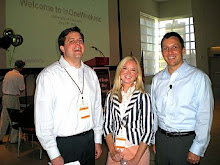A great article from Reid Hoffman, founder and CEO of LinkedIn...
Let Our Start-Ups Bail Us Out
By Reid Hoffman
Tuesday, March 3, 2009; Page A13 - Wall Street Journal
President Obama noted last week that "we have lived through an era where, too often, short-term gains were prized over long-term prosperity." As the $787 billion stimulus is sorted out, we should consider not only what's there but also what's missing. Unless lawmakers move to jump-start key elements of sustainable economic growth, we may find ourselves worse off in a few years.
The stimulus finances important development of infrastructure, renewable energy and scientific research, which is great for jobs in the short term but doesn't guarantee the vibrant economic ecosystem required for sustainability. The credit meltdown, the mortgage crisis and the collapse of automakers have created a climate of fear around investment at precisely the time that new ventures -- not merely new technologies -- need to be championed as the course to stability. Products and services drive a healthy economy. To translate the stimulus into sustainable growth, we need incentives for business innovators.
Entrepreneurs are the fertile soil for job growth and recovery. Small companies represent 99.7 percent of all employer firms, Commerce Department data show. They pay nearly 45 percent of U.S. private payroll and have generated 60 to 80 percent of net new jobs annually over the past decade.
Consider a few start-ups from the past century: Microsoft, MTV, CNN, FedEx, Intel, Hewlett-Packard, Burger King. Each opened during a period of economic downturn. Today, these brands employ hundreds of thousands of people worldwide. We need to prepare for the next Burger King. By empowering individuals and small businesses, an innovation stimulus can help germinate stable industry players for the long term.
Venture capitalists are biding their time -- not for want of good ideas, solid management or stable capital but to ensure that they can get the most bang for their buck. Similarly, venture capital firms are waiting for the slide to stop and the recovery to begin before investing.
The government should improve the situation by offering incentives for entrepreneurship and innovation. How to get started?
First, encourage small business with loans. Apply to the United States the micro-lending model that has proved successful in developing countries, extending credit lines of up to $50,000. Help small businesses invest and grow, reimagine their products and services, and assess their strengths. Localized innovation develops the economy from the ground up.
Second, welcome foreign innovators. Harvard research fellow Vivek Wadhwa reports that immigrants have founded more than half of all Silicon Valley start-ups in the past decade. These immigrant-led, American tech companies employed more than 450,000 workers and grossed $52 billion in 2005. For U.S. companies to employ a highly specialized foreign worker, the employee must hold an H-1B visa, but current law allows for the issuing of only 65,000 H-1B visas per year.
The H-1B cap was established to prevent foreigners from taking American jobs, but, in fact, an education gap frequently leaves American candidates less qualified for these positions. Lawmakers could improve the situation all around by removing the cap on H-1B visas while imposing a 10 percent payroll tax above and beyond the benchmark salary for any position being filled by holders of such visas. The proceeds of the payroll tax could be channeled into U.S. reeducation programs. This compromise would bring the best innovators to work here while subsidizing the continued education of American talent.
Finally, match funds for venture capital and angel investments. Venture firms and investors need financial incentives to invest in companies that create U.S. jobs. What if firms with credible histories could receive as much as $100 million in federal matching funds if their investments create jobs in the United States? Investors could keep their normal return plus 50 percent of the returns on the matching funds, while the other half goes back to the government to revitalize further investment. This would give individuals an incentive to double down on investments they would make anyway, but sooner rather than later.
Having invested in more than 60 start-ups since 2000, I know that financing strategy is key in keeping new ventures afloat. For start-ups, the difference between being a dollar profitable or a dollar unprofitable is life or death. Stable financing lets companies develop good product strategies and become self-sustaining -- and that, on the micro level, is what we need to do with the economy.
This is the time for President Obama to take a page from his campaign playbook. Why stop at tapping the grass roots to debate the stimulus? He should seek to fund innovation at the grass-roots level. Obama is familiar with using YouTube and social networks -- products of start-ups and tools of the people. His administration should make it a point not only to avoid propping up failing, overleveraged institutions but to finance new businesses, back promising ventures, welcome the best foreign minds and nurture native talent. By providing incentives to American ingenuity, we can innovate our way out of this recession.
“I don’t permit a woman to teach”
-
Additional detail on 1 Timothy 2 and Artemis Paul informs Timothy that he
doesn’t “permit a woman to teach or to exercise authority over a man;
rather she ...
6 months ago






